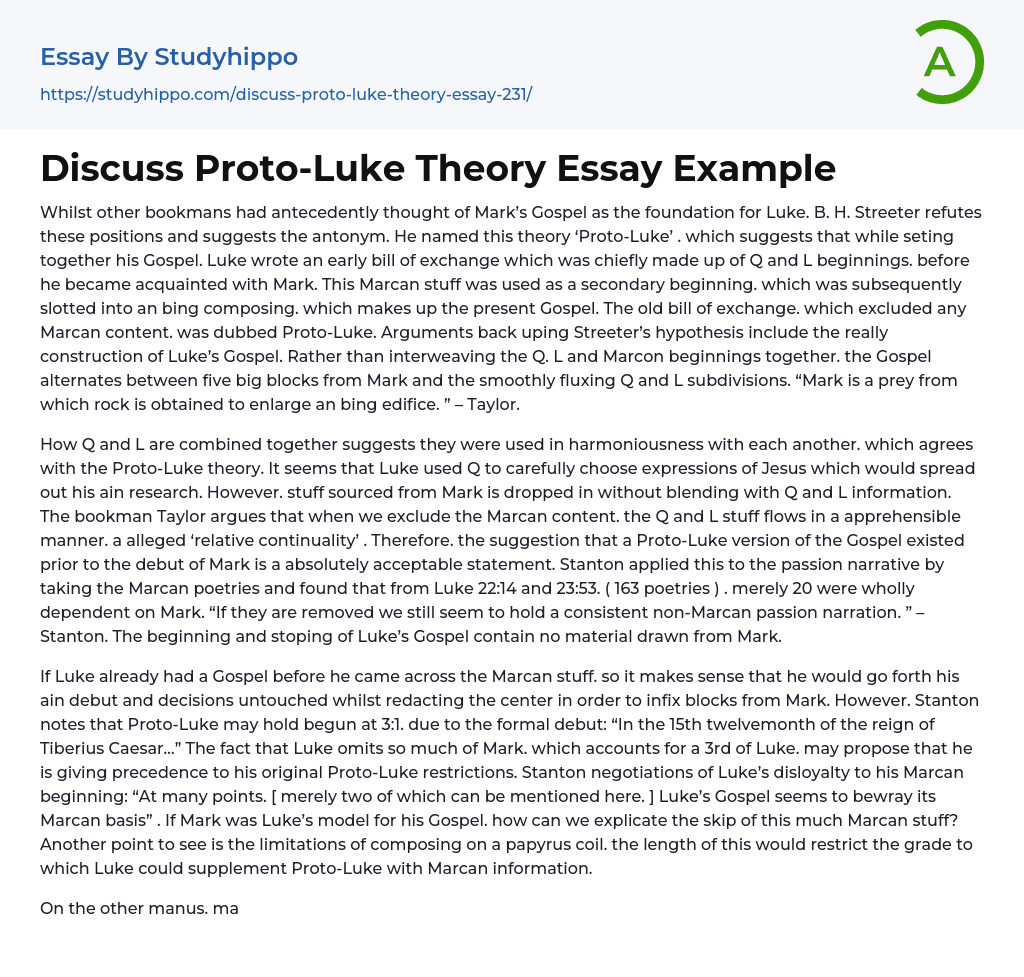B. H. Streeter challenged previous beliefs that Mark’s Gospel was the basis for Luke's Gospel, introducing the opposite theory known as ‘Proto-Luke’. According to Streeter, Luke created an initial draft consisting primarily of Q and L sources before incorporating Mark's material as a secondary source. This was then integrated into the present Gospel which alternates between five large blocks from Mark and the smoothly flowing Q and L sections. Taylor refers to Mark as a resource from which rock is obtained to enlarge an existing building, meaning Q and L were used together in harmony with each other, supporting the Proto-Luke theory. Luke utilized Q to carefully select expressions of Jesus that would expand his own research, while material from Mark was included without blending with Q and L information. Excluding Mark's content allows for a clea
...r and understandable flow of the Q and L material, known as ‘relative continuity’.The idea that a Proto-Luke version of the Gospel predated Mark's debut is a valid assertion, particularly in the case of the passion narrative. Stanton analyzed 163 verses from Luke 22:14 to 23:53 and found that only 20 were entirely reliant on Mark. He suggested that removing these verses results in a consistent, non-Marcan account. The start and end of Luke's Gospel do not draw from Mark, indicating the possibility that Luke had already written his Gospel before encountering Mark's material. Thus, he left his own beginning and end untouched while revising the middle with Mark's material. However, Stanton posits that Proto-Luke may have begun at 3:1 due to its formal introduction referencing "In the fifteenth year of the reign of Tiberius Caesar…” Because Luke omits
significant portions of Mark, which constitute a third of his Gospel, it implies that he prioritized his original restrictions. Stanton also notes Luke's departure from Mark's source material at various points, hinting that Luke may have altered or disregarded Marcan passages intentionally. Finally, it is possible that the length restrictions of a papyrus scroll prevented Luke from supplementing Proto-Luke with a considerable amount of Marcan information.The Proto-Luke hypothesis has faced many criticisms, with some scholars unable to determine which verses were taken from Mark and which belonged to Q and L. Tuckett, however, claimed to have identified Markan phrases in sections of Q and L, casting doubt on the theory. Despite the possibility that Q and L could have existed without Marcan content, gaps in the narrative flow have led some scholars to refer to it as an "amorphous collection," suggesting that Proto-Luke may not have existed. The removal of Marcan material between 8:3 and 9:51 exposes an awkward gap about Jesus' time in Galilee, further contradicting the hypothesis of Proto-Luke's existence. On the other hand, some scholars believe that the awkward inclusion of Marcan content in Q and L supports the validity of Proto-Luke. Luke's compositional style is apparent in Acts and incorporates disjointed shifts between "we" sections and other parts of the Gospel. It is also possible that the infancy narrative was added later, as it does not seamlessly fit with the rest of Proto-Luke's account.Luke's writing style suggests that he tends to combine various sources of information. This approach may not have been limited to the Marcan material that Luke supposedly added to his Proto-Luke draft. It is possible that this is
simply how Luke prefers to write all of his documents. If this is the case, it reduces the credibility of the Proto-Luke theory. Luke may have felt that Mark's Gospel was too important to change, so he incorporated it into his Gospel in the same way he did with other important sources. Scholars like Fitzmyer suggest that certain doublets in the Marcan material indicate that Mark was actually a primary source. Examples include similar phrases such as "to all those who have more will be given, but for those who have nothing, even what they have will be taken away" found in both 8:18 and 19:26. When these phrases appear in Luke's Gospel, one version comes from Mark while the other is from 'Q' (shared with Matthew). Most of these phrases are sourced from Mark, which suggests that Mark was an early model for Luke's Gospel. While patching his Gospel together, Luke may have decided to use Mark in block form. However, this does not mean that the Marcan material was added later in a two-stage process (as noted by Taylor). Guthrie has commented on this hypothesis.According to the text, even though it contained anchoring, it was deemed too weak to justify a complete investigation. It was stated that while the hypothesis may have accounted for some attributes in the case of Luke's breakdown, it cannot be concluded that these features necessarily require the hypothesis.
- Baptism essays
- Holy Spirit essays
- Jesus Christ essays
- Adam And Eve essays
- Crucifixion Of Jesus essays
- Crusades essays
- Eucharist essays
- God The Father essays
- Pope essays
- Protestantism essays
- Christian essays
- Church essays
- Elizabeth essays
- Sacrament essays
- Catholic Church essays
- Lord essays
- Priest essays
- Protestant Reformation essays
- Afterlife essays
- Atheism essays
- Bible essays
- Buddhism essays
- Christian Worldview essays
- Christianity essays
- Confession essays
- Cosmological Argument essays
- Deism essays
- Devil essays
- Existence of God essays
- Faith essays
- Freedom Of Religion essays
- God essays
- Hinduism essays
- Immortality essays
- Islam essays
- Jainism essays
- Jews essays
- Judaism essays
- Miracle essays
- Monk essays
- Monotheism essays
- New Testament essays
- Old Testament essays
- Pilgrimage essays
- Puritans essays
- Revelation essays
- Ritual essays
- Salvation essays
- Sin essays
- Sinners essays




